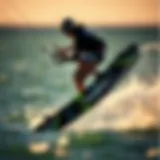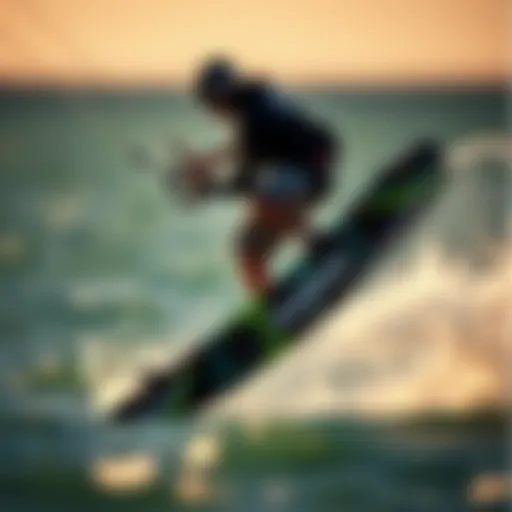Mastering Oahu's Weather for Kiteboarding Success
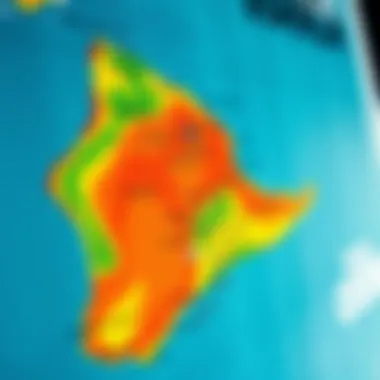
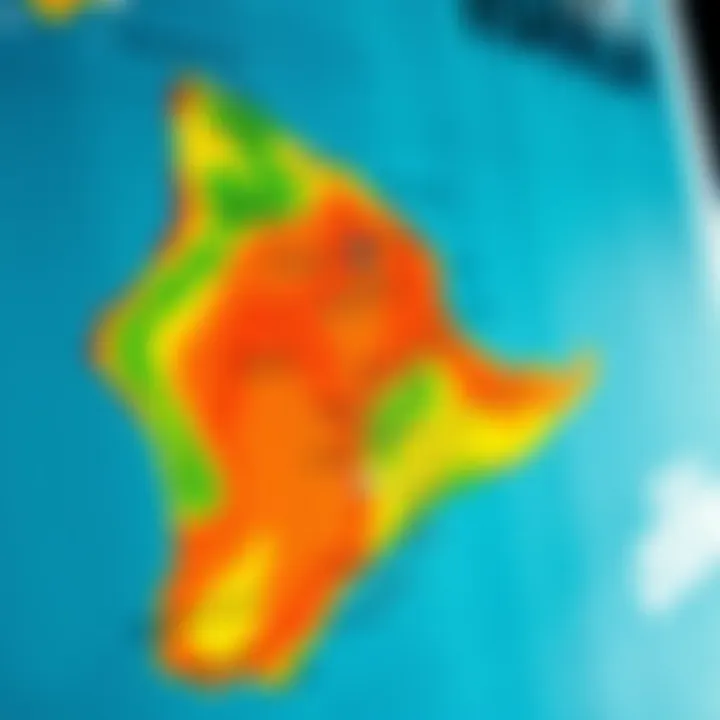
Intro
Kiteboarding in Oahu is something out of a dream, but flying through the air requires more than just a kite and a strong desire for adventure. For those who dare to ride the winds, understanding the local weather map is essential. Oahu's weather isn’t just a simple afterthought; it's a dynamic tapestry that weaves together the rhythm of the ocean, the patterns of the wind, and the shifting moods of the sky. A novice's journey can quickly lead to smooth sailing or turbulent waters, depending on the weather.
By delving into Oahu’s unique weather phenomena, kiteboarders can unveil the secrets behind optimal kiteboarding conditions. This guide will take a closer look at the nuances of wind speeds, seasonal shifts, and precipitation, providing kiteboarding enthusiasts with the necessary tools to navigate the skies safely and effectively.
With local forecasts at your fingertips and an understanding of how different weather elements interact, kiteboarding becomes not just a sport but an experience enriched with confidence and knowledge. This resource aims to equip you with insights that are both practical and enlightening, whether you're a seasoned kiteboarder or just starting out.
It’s time to strap on your board, check the skies, and get ready to conquer the winds of Oahu head-on!
Understanding the Oahu Climate
Understanding Oahu's climate is absolutely crucial for kiteboarders. The island's unique weather patterns directly influence the kiteboarding experience, making it essential for enthusiasts to familiarize themselves with these climatic subtleties. Knowing what to expect from the weather means you can optimize your time on the water, whether you are a rookie rider or an experienced kiteboarder. With various factors at play, from seasonal winds to temperature fluctuations, grasping the essence of Oahu's climate can pave the way for thrilling kiteboarding sessions.
Overview of Oahu's Climate Zones
Oahu's climate can be categorized into several distinct zones, each with its unique characteristics. The northern and eastern shores experience a tropical climate, known for its lush vegetation and abundant rainfall. This often translates to higher humidity levels and mild temperatures which assist in creating a comfortable environment for those venturing outdoors. Meanwhile, the southern coastline, particularly around Honolulu, tends to be markedly drier, offering consistent sunny days ideal for kiteboarding.
Here are some elements to consider in Oahu's climate zones:
- Wind Patterns: Vary across the island, affecting kiteboarding conditions.
- Elevation: Higher altitudes can lead to cooler temperatures and more precipitation.
By understanding these zones, kiteboarders can choose the best locations to catch the wind while also enjoying the beautiful scenery that Oahu offers.
Influence of Topography on Weather Patterns
The unique topographical features of Oahu play a significant role in the island's weather patterns. The Ko'olau mountain range, which runs along the east side of the island, acts as a barrier to the trade winds. As these winds sweep in from the ocean, they are forced upward, leading to cooler temperatures and increased rainfall on the windward side. Conversely, the leeward side experiences a rain shadow effect, where conditions are drier and sunnier due to the mountains obstructing humidity and precipitation.
This topography results in varied kiteboarding conditions across the island:
- Wind Direction: Wind conditions may differ depending on proximity to mountains.
- Local Precipitation: Some spots might be wet while others are parched, guiding selections for best session spots.
Seasonal Climate Variations
Understanding seasonal variations is key to planning your kiteboarding trips. Oahu experiences two primary seasons: the dry season from May to September and the wet season from October to April. During the dry months, trade winds are generally stronger and more reliable, providing the perfect backdrop for kiting enthusiasts.
Conversely, the wet season offers lighter winds but brings the benefit of warmer sea temperatures, although kiteboarding may be more sporadic as rainstorms can roll in unexpectedly. Here are some critical points to keep in mind:
- Dry Season: Predictable wind patterns, ideal for extensive kiteboarding.
- Wet Season: Unpredictable and variable; not to be underestimated for extreme kiteboarding adventures.
- Recommended Gear Adjustments: As conditions change, so should your gear to stay safe and effective in the varying weather.
Key Elements of the Weather Map
When it comes to kiteboarding in Oahu, a solid grasp of the weather map’s fundamental aspects is non-negotiable. Kiteboarding thrives on the right wind conditions, so knowing how to read these elements can dictate the difference between an exhilarating session and a frustrating washout. The key elements focus on wind direction, speed, temperature, and precipitation. These are the pillars supporting all the kiteboarding fun.
Interpreting Wind Direction and Speed
Wind direction and speed are akin to the pulse of kiteboarding. They dictate not just the potential thrill of your ride but also your safety. Photographers may hunt for the perfect light, but kiteboarders track the wind. It’s essential to familiarize yourself with the terms used in meteorological contexts, as these will often appear in forecasts.
To interpret wind direction, it's crucial to understand the standard nomenclature. Winds are often categorized using the compass: for instance, if you see a North wind, it's blowing from the north toward the south. This impacts your launch and landing zones significantly.
- Wind Speed: Measured in knots, this indicates how forceful the wind will be. A modest breeze of around 10-12 knots might lend itself to a comfortable ride, while winds over 25 knots can become challenging, even dangerous, depending on your skill level.
- Utilization of Resources: Websites like Windy.com provide real-time data, while tools like Kiteboarder.com offer helpful insights into local conditions.
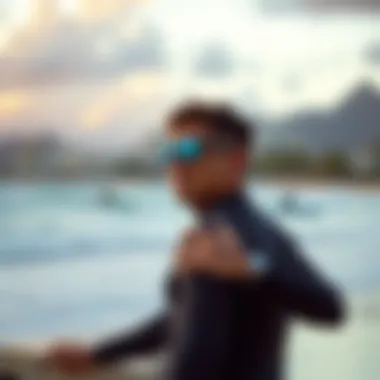
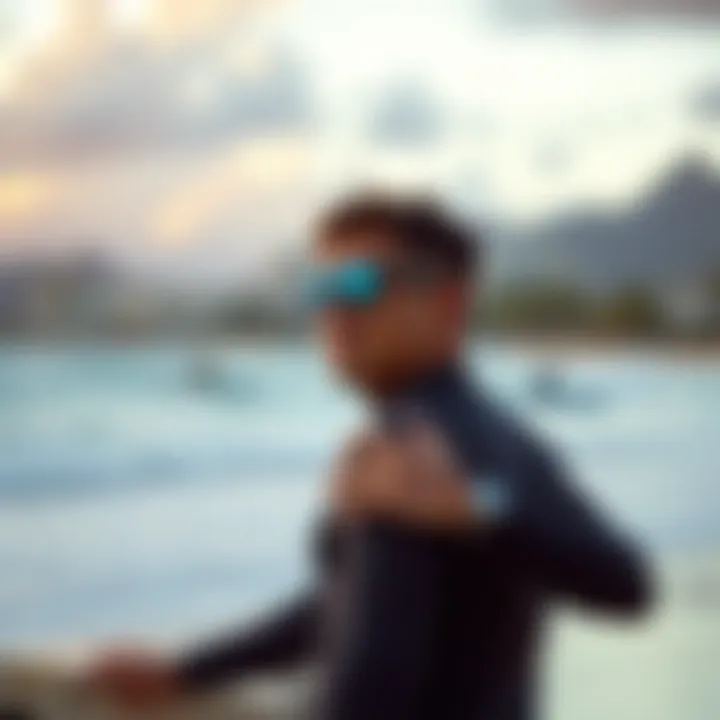
Understanding Temperature Trends
Temperature, like wind, can be divided into patterns that play a vital role in your kiteboarding experience. It’s no longer just about whether it's hot or cold; it’s about knowing the subtleties of thermal dynamics affecting each session.
- Daytime vs Nighttime: Daytime heat can boost thermal winds in specific areas, making mornings and afternoons ideal for kiteboarding. Conversely, evening temperatures may bring a lull.
- Comparative Awareness: Understanding temperature shifts also helps you prepare your gear. For instance, the bite of early morning or late afternoon chill might call for a lightweight wetsuit to keep your body functioning at optimum performance.
- A useful guideline is to accompany temperature forecasts with wind patterns to predict the most suitable kite size. Using apps like Noaa.gov can be incredibly effective in tracking these changes.
Precipitation Patterns and Their Effects
Rain may not always dampen the mood, but it certainly can impact your kiteboarding experience. Knowing how to interpret precipitation patterns is essential for any kiteboarder.
- Forecast Awareness: Rain can sweep in unexpectedly; however, it often accompanies shifts in wind. If you're eyeing a fun session, keep an eye on that forecast. Mapping out areas that experience less rainfall can help you choose your kiteboarding spot wisely.
- Impact on Water Conditions: Heavy rains may alter water surface conditions, affecting how your board interacts with the sea. Muddy or choppy waters, often the after-effects of rainfall, can create an entirely different experience.
"The key to enjoying kiteboarding lies not just in riding the best waves but also understanding what’s brewing above you. Your experience can change in a heartbeat." – Local Kiteboarder
- Preparing for the Unexpected: Ensure that you’ve packed appropriate gear just in case rain clouds roll in, keeping a waterproof cover for your kite or even a quick-dry jacket within arm's reach.
In sum, mastering these key elements of the weather map isn't simply an exercise in meteorological literacy; it's about fine-tuning your kiteboarding craft. By grasping how wind, temperature, and precipitation all interplay, you’ll align your adventuring spirit with the intricacies of nature, ensuring that your time on the water is nothing short of extraordinary.
Best Times for Kiteboarding in Oahu
Kiteboarding enthusiasts often find themselves harmonizing with the elements. Knowing when to ride can make or break an adventure. The best times for kiteboarding in Oahu not only relate to the optimum wind speeds but also the overall climate nuances that contribute to exhilarating sessions. Understanding these seasonal dynamics will allow kiteboarders to optimize their time on the water and maximize enjoyment.
Peak Wind Seasons
In Oahu, the winds dance differently throughout the year. The peak wind seasons generally span from April to October, but it varies by location on the island. For instance, the North Shore tends to experience stronger easterly trade winds during this period, making it ideal for kiteboarding. Conversely, the South Shore is often favored during the summer months as winds shift slightly.
Indeed, many kiteboarders report that summer provides reliable conditions. The warm trade winds mean that kiteboarders can count on favorable weather, often reaching speeds of 15 to 25 knots. This consistency can create perfect conditions that also provide opportunities for beginners to learn in a safer environment.
"A consistent breeze and warm waters make summer a kiteboarder's paradise in Oahu."
However, local knowledge is crucial. Seasonal changes can alter wind patterns. Hawk-eyed enthusiasts would do well to keep an ear to the ground and consult local forecasts before heading out.
Monthly Breakdown of Conditions
When it comes to kiteboarding in Oahu, each month has its unique charm. Here's a breakdown to help kiteboarders choose their target times:
- January – March: These months can feature lighter winds and occasional rainy days which might not be ideal for everyone. The trade winds are less predictable, yet some seasoned riders appreciate the challenging conditions.
- April – June: As spring rolls in, expect the winds to pick up. April often marks a transition point, leading to more reliable conditions by May and June. Prepare for afternoon breezes that can bring afternoon showers.
- July – September: These are the golden months. Winds become consistent, and kiteboarders flock to various spots around the island. The swells also provide pleasant challenges for intermediate and advanced riders.
- October – December: Wind patterns can shift again. The North Shore might see some fantastic sessions with the onset of winter swells but approaches caution. As the weather cools, rain patterns can emerge.
In essence, the best monthly conditions for kiteboarding hinge on preparation and awareness. A well-timed kiteboard session can enhance overall experiences and skills significantly.
Local Events and Competitions
Local kiteboarding events add vibrancy to the overall experience of being on Oahu. From competitions to community gatherings, these events not only showcase skill but also foster camaraderie among riders. The Annual Aloha Kite Fest, typically held in July at Kailua Beach, is one standout occasion where locals and travelers congregate to share their passion for the sport.
Participation in such events can enhance one’s riding techniques, provide networking opportunities, and allow kiteboarders to gain invaluable insights from seasoned pros. Although competitive, the atmosphere is often relaxed and supportive. During local competitions, watching styles and strategies can be both inspiring and educational.
Moreover, being aware of these events can assist in planning trips. Kiteboarders can align their visit with such competitions, fully immersing themselves in the Oahu kiteboarding culture. Checking local calendars or joining groups on platforms like Facebook or Reddit can keep you in the loop.
In summary, understanding the best times for kiteboarding in Oahu opens up vast opportunities for adventure. From peak wind seasons, detailed monthly conditions, to engaging with the local kiteboarding community through events, one can craft a memorable and adrenaline-fueled experience on the stunning waters of Oahu.
Forecasting Tools and Resources
Understanding the best practices in kiteboarding goes hand-in-hand with having the right tools for forecasting. As conditions can change on a dime in Oahu, knowing how to effectively use various forecasting tools can make all the difference for your safety and enjoyment. The right resources not only aid in planning your sessions but also enhance your performance on the water. Without a keen sense of awareness about weather conditions—like wind speeds, temperature fluctuations, and potential storms—kiteboarding can quickly turn risky. No one wants to find themselves battling gusty winds or unexpected rain.
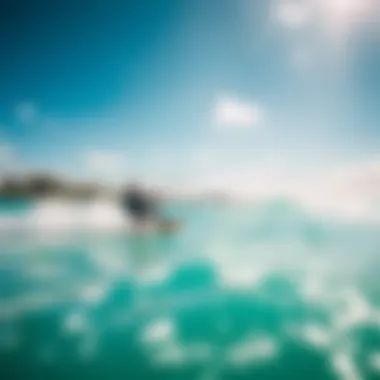
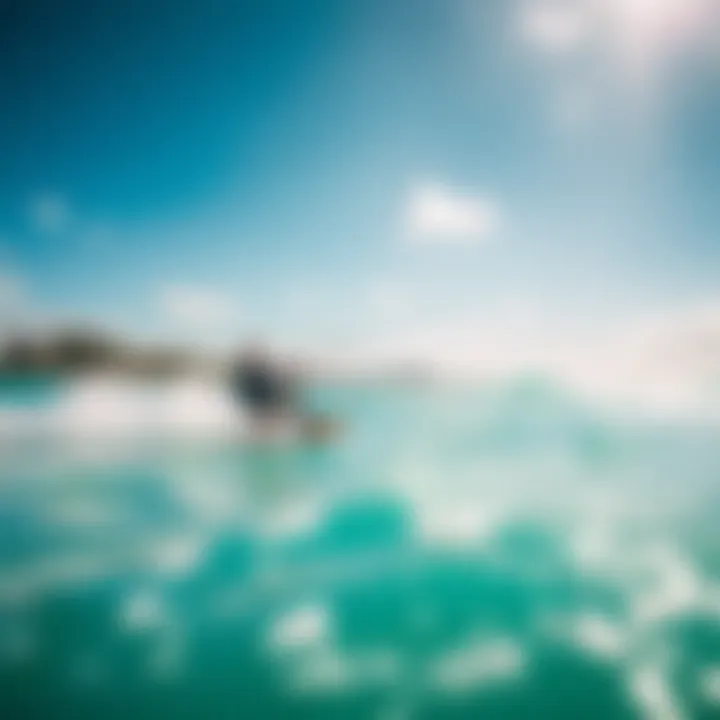
Utilizing Online Weather Services
Online weather services are indispensable when kiteboarding in Oahu. Websites such as Windy.com and NOAA provide real-time updates that are essential for a great ride. Here's what to consider:
- Wind Data: You’ll want precise measurements. An ideal wind speed for kiteboarding typically sits between 12 to 25 knots. These services deliver specific forecasts that cater to your needs.
- Temperature Readings: Keeping an eye on air and water temperatures can ensure that you dress appropriately and also understand potential thermal uplifts that can affect wind conditions.
- Precipitation Alerts: Knowing what's coming helps you make informed decisions. No one enjoys kiteboarding in the rain or under thunderclouds.
Remember, no service is perfect; always cross-reference multiple sources before hitting the water.
Mobile Apps for Wind Forecasting
Mobile applications add another layer of convenience for kiteboarders. Having a reliable app on your smartphone can be a game-changer when you're out and about. Popular apps like Kite Surf & Snow and Windy give you info on the go. Consider the following benefits:
- Real-Time Notifications: Get alerts for wind changes, which helps in instant decision-making.
- User-Friendly Interfaces: Most apps feature easy-to-navigate layouts, allowing you to quickly jump to the information you need.
- Integration with Local Conditions: Many apps allow user-generated reports, giving you on-the-ground insights, which can be particularly useful for less predictable weather.
With a pinch of practice, using these apps can elevate your kiteboarding experience.
Local Expertise and Community Insights
No amount of technology can replace local knowledge. Engaging with experienced kiteboarders in Oahu can offer tips that online services cannot provide. Here’s why community insights matter:
- Personal Stories: Conversations with locals yield anecdotes about changing weather or secret spots that are less crowded. Sometimes, the best advice is found in stories shared over a coffee.
- Connecting with Instructors: Instructors often have their fingers on the pulse of ideal conditions for learning. Taking the time to consult them could save you from making novice mistakes.
- Social Media Groups: Platforms like Facebook or Reddit have groups dedicated to kiteboarding in Oahu. Joining these can keep you updated on immediate weather concerns and allow you to engage with fellow enthusiasts.
"In kiteboarding, experience from the locals can be your compass in an ever-changing landscape. Don't just rely on forecasts; listen to the wind whispers shared by the community."
Navigating the winds and tides in Oahu requires more than just desire; it demands a toolkit of reliable resources and a strong connection to the kiteboarding community.
Impact of Weather on Kiteboarding Safety
Understanding the connection between weather and kiteboarding safety is paramount for anyone looking to enjoy the thrill of riding the waves. Kiteboarding, with its reliance on wind and weather conditions, can pose risks if one is not well-prepared. Failing to recognize the influential role that weather plays can lead to dangerous situations or accidents. A kiteboarder who is attuned to the subtleties of weather can maximize enjoyable experiences while minimizing risks.
Identifying Hazardous Conditions
The first step towards ensuring a safe kiteboarding experience is being able to identify hazardous conditions. Pay close attention to local forecasts and current weather patterns, as they can change in the blink of an eye. Certain indicators often point to unsafe conditions:
- Strong gusts: Sudden shifts in wind speeds can cause serious trouble, particularly for less experienced riders. It’s best to check local updates reflecting peak gust speeds.
- Stormy weather: Dark clouds on the horizon could signal incoming storms, and lightning is a kiteboarder’s worst enemy. Always keep an eye on the skies.
- Water conditions: Choppy waves or strong currents can complicate your ride, so it’s wise to ask locals about recent water conditions.
It’s an old saying among kiteboarders – "better safe than sorry." It rings true when you’re out there on the water.
Correct Safety Protocols During Extreme Weather
When confronted with extreme weather, having the right safety protocols in place can make a world of difference. The importance of these protocols cannot be overstated; they can prevent accidents and preserve life.
- Choose the right gear: Ensure your equipment is suitable for extreme conditions. For example, if the wind picks up unexpectedly, switching to a smaller kite might be necessary.
- Buddy system: Kiteboarding with a friend is not just good company; it provides an additional layer of safety. If something goes awry, having someone there can help address emergencies swiftly.
- Know when to de-rig: If conditions worsen too much, don't hesitate to pack up your gear and seek safety on land. Every seasoned rider has had days when they had to cut their sessions short. Better to come back another day.
Preparing for the worst isn’t about being pessimistic; it’s about being responsible.
Adapting Techniques to Weather Variations
Kiteboarding is as much about technique as it is about enjoying the wind in your hair. Adapting your techniques to accommodate changes in weather can improve your ride and keep you safer.
- Adjusting stance: On gusty days, a lower stance often lends better control. Bend your knees and keep your weight centered over the board to navigate winds that shift unexpectedly.
- Using the kite’s power: If the wind is lighter, riders can often increase their kite’s apparent wind by heading downwind. This requires conscious acceleration and braking with your body weight, a practice that can be honed over time.
- Stay aware of surroundings: Every ride should be monitored closely for changes, such as nearby boat traffic or changing weather conditions. Keeping your head on a swivel isn’t just for good looks; it’s a key component of safety.
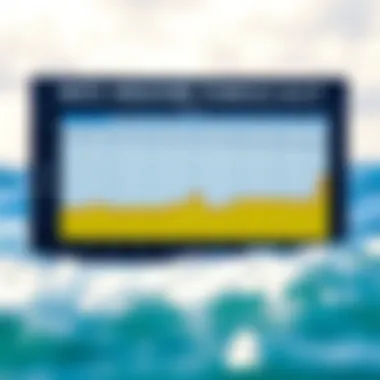
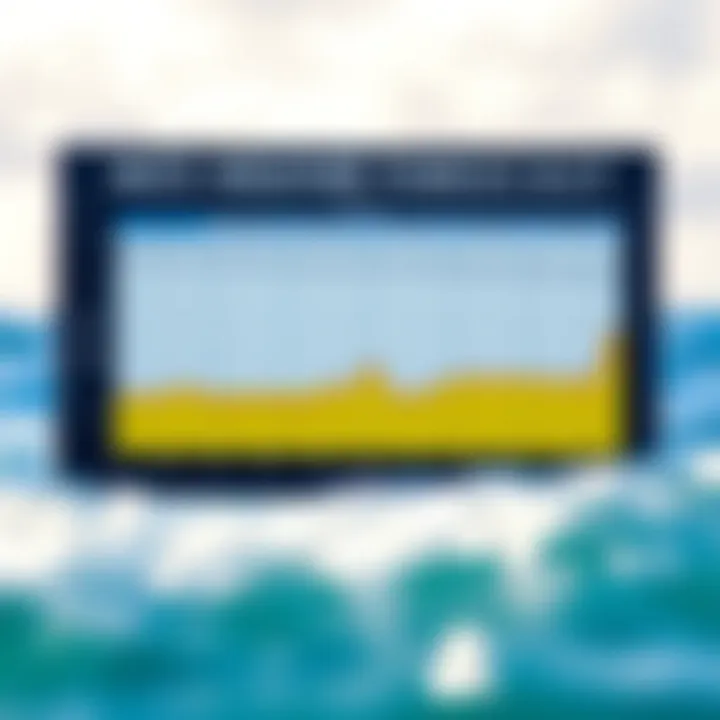
Combining these techniques with solid knowledge of the forecast allows kiteboarders to make informed decisions on the water. Being adaptable equips riders with the confidence to tackle the elements head-on.
By staying vigilant about the weather, riders can ensure they have fun while navigating the stunning shores of Oahu.
Personal Accounts: Kiteboarders' Weather Experiences
Understanding the myriad ways weather can affect kiteboarding is not merely an academic exercise. Instead, the personal accounts of kiteboarders who face Oahu’s capricious weather provide valuable insights. These anecdotes not only enhance the collective knowledge of the kiteboarding community but also offer real-world context. Kiteboarding isn’t just about the technical aspects; it’s also about the passion, excitement, and sometimes, the unpredictability that accompany each session. Whether you're a novice still finding your footing or a seasoned pro, learning from others’ experiences is crucial for safety and performance improvement.
Stories from Local Kiteboarders
Kiteboarders from Oahu often have tales that could easily fill a book. Take, for example, the story of Sarah, a local who recalls her first kiteboarding venture at Kailua Beach. On a day when the forecast looked promising, she launched her kite only to discover that what seemed like friendly winds turned into streaky gusts that nearly unseated her. The frantic moments that followed taught her to not just rely on maps but also to gauge the winds herself.
Another fascinating account comes from Jake, who rides regularly at Lanikai. He encountered a sudden rain shower that brought unexpected onshore winds. Instead of panicking, he learned to enjoy the thrill of unpredictable conditions. "It’s amazing how quickly weather changes here, but it just adds another layer to the experience," he shares. These personal revelations underline that every kiteboarding adventure carries unique lessons, often rooted in weather experiences.
Lessons Learned from Bad Weather Days
Mistakes often yield the most profound lessons. Bad weather days are the ultimate teacher in kiteboarding. One local kiteboarder, Mark, experienced a nerve-wracking session when he ignored warning flags. The wind shifted dramatically, catching him off-guard, and resulted in a harrowing experience that nearly ended in injury. "I learned the hard way to always check conditions thoroughly," Mark reflects.
More than just a cautionary tale, Mark’s experience serves as a reminder that weather assessment needs to be proactive. Observing cloud formations, checking temperature changes, and even consulting local forums or Facebook groups can be lifesavers. Fellow kiteboarder Lisa emphasizes this. She recalls being stuck on a kite because she underestimated the wind pattern changes. "I always check the online local spot reports now, just to be safe," she says.
Memorable Sessions in Perfect Conditions
Perfect weather can create kiteboarding memories that last a lifetime. Local sharers recount days that seemed like something out of a postcard. One kiteboarder named Carlos speaks about a sun-drenched afternoon, winds perfectly steady at twenty knots, creating optimal conditions for jumping and tricks.
"It felt like flying, something otherworldly, with the waves choreography just right," he explains, highlighting that a good day isn’t just about the wind speed but also about ambiance. Another kiteboarder, Monique, recalls a sunset session that was pure magic; warm winds in harmony with glimmering waters changed color like an artist’s palette.
Moments like these define what kiteboarding is all about. They remind riders that despite potential risks, when conditions align, the rewards are unparalleled.
Reflecting on personal experiences and shared stories can help kiteboarders make informed decisions. It highlights both the joy and unpredictability associated with wind conditions, making the knowledge gained from the community invaluable.
Each personal tale contributes to a rich tapestry of experiences that give depth to the kiteboarding community in Oahu. Taking these narratives into account not only enhances one's skills but also fosters community connections.
Keep this in mind the next time you gear up for a session; sometimes, the weather’s unpredictability leads to the best stories.
The Future of Kiteboarding in Changing Weather
As kiteboarding continues to gain traction in Oahu and beyond, understanding the implications of changing weather patterns is vital for both enthusiasts and professionals in the sport. The future of kiteboarding is intertwined not just with technical advancements in gear, but also with the environmental changes that are reshaping the skies and waters we navigate. Making sense of these alterations allows kiteboarders to predetermine optimal riding conditions, ensuring both safety and satisfaction on the water. The intersection of climate and kiteboarding emphasizes the urgent need for participants to stay informed, adapt, and promote practices that align with a rapidly changing environment.
Climate Change and Its Impacts
Climate change impacts can be seen everywhere, from increasing temperatures to more extreme weather events. For kiteboarders, it's crucial to recognize how these changes affect our beloved pastime. The rise in ocean temperatures can alter current patterns, shifting wind behavior, which is essential for kiteboarding. Stronger storms might seem appealing for advanced riders, but they also introduce unpredictability and potential hazards. Additionally, coastal erosion is accelerating, threatening the very beaches kiteboarders rely on. As we navigate this complex terrain, staying aware of local and global climate patterns gives kiteboarders a leg up when planning their epic rides.
"As environmental conditions evolve, so must our approach to kiteboarding, ensuring we remain continually prepared for what's ahead."
Adaptations in Kiteboarding Gear and Techniques
To face the challenges posed by changing weather, kiteboarders should consider investing in gear that accommodates variable conditions. Modern kite designs and materials have evolved to provide versatile performance across a range of wind strengths and weather scenarios. This includes:
- Multi-purpose kites that perform well under diverse wind conditions.
- Adjustable lines that allow for quick re-tuning on windy days.
- Lightweight boards that can help maintain stability in increasing surf conditions.
Moreover, techniques that focus on adaptability, such as learning to navigate in shifting winds, can enhance skills and preparedness on the water. Practicing in different conditions and honing specific maneuvers can minimize risks associated with sudden weather changes, allowing kiteboarders to ride safely while mastering their craft.
Encouraging Sustainable Practices
As the future of kiteboarding hangs in balance with environmental integrity, it’s critical for kiteboarders to advocate for sustainable practices within the sport. This can be achieved by:
- Using eco-friendly gear, such as kites made from recycled materials.
- Participating in local beach clean-ups to protect coastal environments important for kiteboarding.
- Promoting education on weather patterns and sustainable practices within the kiteboarding community.
By fostering a culture centered on sustainability, the kiteboarding community can ensure that it thrives for generations to come, creating a responsible legacy for those who will follow. The thrill of kiteboarding in Oahu can continue to be a source of joy, while also playing a part in mitigating the effects of climate change.










